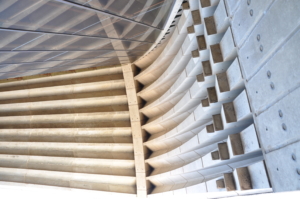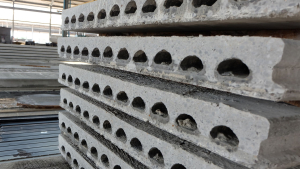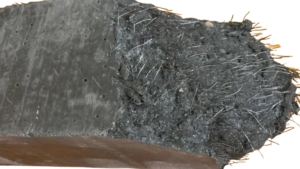Most people are familiar with concrete. However, many people don’t know that there are many different types of concrete and applications for them. Two casting methods are precast concrete and cast-in-place concrete.
Most people are unaware of these two types of concrete. Even people familiar with these basic types often question the differences between precast vs cast-in-place concrete.
Therefore, this article will discuss these two methods of casting concrete. After reading the information provided here, you will be aware of the pros and cons of each method and find out which is the better option for you.
What is the Difference Between Precast Concrete and Cast-in-Place Concrete?
Here is an overview of both types:
What is Precast Concrete?
Prefabricated concrete or precast concrete is poured offsite in specific pre-made molds, cured offsite in ideal conditions, and then transported to the job site. The curing conditions are not always ideal at a construction site. Therefore, precast concrete provides a higher quality structure, as the curing or hardening process takes place in optimal conditions.
Precast units come in different shapes made in controlled precast facilities. The manufacturers use high-end raw materials that can be difficult to source for local builders. The precast panels are shipped to the final job site.
What is Cast-in-Place Concrete?
Cast-in-place concrete is poured directly on the building site to form the desired structural system or application. The concrete then cures within the environmental conditions of the site. There is no transportation required for the cured concrete. This concrete is commonly called site-cast concrete.
Site casting involves pouring concrete directly into a mold on-site to achieve the required shape for specific construction projects. Although no transportation is required, there is an increased requirement for other labor. The curing of the concrete itself takes weeks. Additionally, weather conditions can stall the construction project duration for months.
What are the Advantages of Precast Concrete?
Precast concrete has the edge when compared with site-cast concrete directly. Here are some of the advantages of precast concrete:
Simplified Material Inputs
In the case of precast concrete, the materials that the builders need to order are prefabricated concrete slabs or a single precast unit. They arrive on-site ready to install. However, in the case of site-cast concrete, a range of materials need ordering. Once ordered, choosing the ratio of each material in the mix must be considered. Therefore, precast concrete offers a much-simplified approach.
Faster Construction Time
The concrete curing process is time intensive and can take days or weeks regardless of where it is cast. However, in the case of precast concrete, the manufacturing plant has already cured it beforehand in vast quantities. Therefore, the builder can order the slabs without waiting for the curing period of concrete. Less waiting time leads to less time needed for construction on-site.
Cheaper Option
Precast products such as panels or slabs are less expensive than cast-in-place concrete slabs. While they can seem expensive to purchase, remember that cast-in-place concrete construction requires labor to mix and pour the concrete. Additionally, some of the concrete is wasted in the process. Therefore, precast concrete saves both time and money overall.
Cost Effective for Large Scale Projects
In large-scale projects, every day spent in the construction phase is critical. Builders cannot wait long for concrete curing because it means extra costs and downtime. Additionally, there is always the risk of something going awry due to weather conditions. Therefore, precast concrete panels are cost-effective for large projects.
Complete Quality Control
Mass-produced precast concrete is made in a completely controlled environment by expert professionals, undergoing complete quality control at all stages – a strictly controlled process. However, the same level of quality control is impossible for site-cast concrete. Firstly, the labor on site isn’t that technically experienced. Secondly, it is tricky to monitor site-cast concrete at all times.
Less Prep Work
In the case of precast concrete structures, there is little to no prep work required. The concrete panel is premade and only requires installation on the job site. However, pour-in-place concrete requires a lot of prep work, firstly to create the concrete and then to make the necessary molds to form it.
Independent of Weather Conditions
One of the best things about precast concrete is that it is independent of weather conditions. Weather is the most critical factor that determines concrete curing on-site. Precast concrete slabs are cured in a controlled environment where the temperature and humidity are optimal. Therefore, the resultant concrete construction is of exceptional quality.
There is no control over environmental factors in the case of on-site concrete pouring. Poor weather can lead to cracks in the concrete structure.
Less Labor Requirement
Precast concrete requires labor on-site only for the installation of the concrete panel. Site-cast concrete requires labor on-site for preparing the concrete, pouring, and curing. Therefore, precast concrete wins when comparing the labor required vs. that for site-cast concrete.
Insulation
Factories manufacture precast concrete with professional equipment and expert guidance, so adding insulation to the concrete slab is an option. However, with site-cast concrete, adding insulation needs a separate layer in the building interiors. Therefore, precast concrete is space-saving and requires less labor due to inbuilt insulation.
Specialized Reinforcement
As with insulation, precast concrete offers the option to add specialized high-strength concrete reinforcements. Builders can opt for this when using a concrete slab as beams and load-bearing structures. However, site-cast concrete does not offer an equally varied range of specialized reinforced materials.
Surface Finishing
Precast concrete offers many options when it comes to surface finishing. Common finishes include form finish, acid etched finish, sandblasted finish, exposed aggregate finish, and polished finish. However, there are no such finishing options in situ concrete.
Versatility in Designs
Precast factories have an array of molds at their disposal. Therefore, there are a large number of designs available. However, site-cast concrete has limited molds, so there are limitations in mold designs.
Does Cast-in-Place Concrete Have Any Advantages Over Precast Concrete?
Since there are two sides to every coin, site-cast concrete indeed offers some advantages over precast concrete. Some of these advantages include the following:
Handling and Lifting Requirements
Precast concrete requires cranes and other heavy equipment to lift the concrete panels into place. Since site-cast concrete is a pour-in-place solution, there is no requirement for such lifting equipment on the construction site.
Cost Effective For Small Structures
Precast concrete is cheaper for large projects such as commercial construction sites because all the heavy equipment required is already on such sites and used for other purposes as well. However, cast-in-place concrete construction can be cheaper for small-scale projects such as house construction.
Comparison Table
Here is an overview table comparing precast concrete to site-cast concrete:
| Factor | Precast Concrete | Site Cast Concrete | Winner |
| Quality | Uses the best materials possible | Uses the locally available options | Precast Concrete has a better quality |
| Durability | Highly durable due to better materials used | No guaranteed durability due to variation in materials | Precast concrete is more durable |
| Versatility | Highly versatile due to customized size, shape, finishes, and reinforcement options | Versatile in shape but no option for variation in other elements like finishing | Both are versatile in shape but precast concrete has a better overall versatility |
| Strength | Significantly higher strength due to controlled manufacturing and added reinforcements | Limited strength due to environmental factors and lack of quality reinforcements | Precast concrete has significant edge in terms of strength |
| Cost | Costly initially but cost saving overall in large constructions | Cheaper initially but more expensive overall for large constructions | Precast concrete is cheaper for large scale constructions whereas site cast is cheaper for small scale construction |
| Human Labor Dependency | Low labor dependency since labor is only required for installation | High labor dependency since labor is required for concrete making and pouring | Precast concrete is the better choice since it is independent of labor requirements |
| Preparation Work | No preparation work required, simply buy the panel and install it as it is | Preparation work is required for the concrete as well as the job site | Precast concrete has lower preparation work requirement |
| Curing Conditions | Cured in idea conditions with controlled temperature and humidity | Cured outdoors without any control over temperature or humidity | Precast concrete |
| Quality Control | High quality control due to constant monitoring over the entire process | No quality control since constant monitoring is not possible at the job site | Precast concrete |
| Installation Time | Some installation time is required since concrete slabs need to be fixed in place | No installation time required since concrete is poured directly in place | Site cast concrete |
| Total Construction Time | Low construction time due to elimination of prep work and curing process | High construction time due to weeks spent in concrete curing | Precast concrete |
| Transportation Cost | High | Low | Site cast concrete |
| Joints | Presence of joints when merging of different panels | No joints present | Site cast concrete |
| Heavy Machinery Requirement | Required for lifting and installation of panels | Not required | Site cast concrete |
| Earthquality and Wind Resistant | High due to reinforcements and structural elasticity | Variable | Tie |
| Weather Dependency | Independent of weather conditions since curing happens off-site | Highly dependent on weather conditions | Precast concrete |
Conclusion
When choosing between precast concrete and cast-in-place, precast has an edge. A precast concrete structure is stronger, faster to make, and less expensive for large residential and commercial projects.
To reap the full benefits of precast concrete structures, source them from a quality brand. Premier Precast is the leading manufacturer and supplier of various great precast concrete products. These products can be designed to the builder’s requirements and include wall panels, precast slabs, basement walls, roof panels, and more.
Frequently Asked Questions
Here are the answers to some commonly asked questions regarding precast vs in situ concrete:
Is precast concrete cheaper than cast-in-place concrete?
Precast concrete is cheaper for a large construction project, while cast-in-situ concrete is cheaper for a small project like a single house.
Why is precast concrete better than cast-in-situ concrete?
Precast concrete is better than cast-in-situ concrete for every factor, such as superior quality, lower construction costs, a wider choice of surface finishes, faster construction time, and more.





